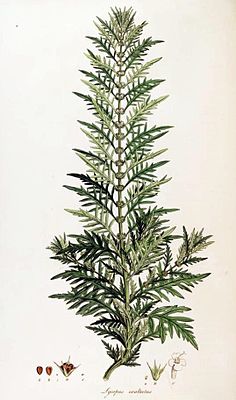High Wolfstrapp
| High Wolfstrapp | ||||||||||||
|---|---|---|---|---|---|---|---|---|---|---|---|---|

Tall Wolfstrapp ( Lycopus exaltatus ), illustration |
||||||||||||
| Systematics | ||||||||||||
|
||||||||||||
| Scientific name | ||||||||||||
| Lycopus exaltatus | ||||||||||||
| Honor |
The High Wolfstrapp ( Lycopus exaltatus ) is a plant from the family of the mint (Lamiaceae).
description
The Hohe Wolfstrapp grows as an evergreen, perennial herbaceous plant and reaches heights of 90 to 160 cm. Its appearance is similar to the Ufer-Wolfstrapp . Its stems , however, are hairy bald to downy. The leaves are rough and deeply pinnately split on both sides.
The flowering period extends from July to September. The Scheinquirle are not very flowered. The white flowers are about 3 to 4 millimeters long. The calyx teeth do not prick and are as long as the calyx tube. The nuts are almost as long as the chalice.
The number of chromosomes is 2n = 22.
ecology
Pollination takes place via insects and the spread of the diaspores via water and Velcro spread.
Occurrence
The Hohe Wolfstrapp occurs in Europe and from Western Asia to China. While it is considered endangered or extinct in all of Central Europe, it is partly common in Eastern Europe and consistently in Bashkiria , Kazakhstan and Ukraine . It represents a subcontinental element of the South Siberian-Pontic forest steppe areas. In Europe, it spread further north only along the large river valleys. So it was found in 1856 in the north-western part of the Kreuzhorst near the Elbe near Magdeburg , but was already considered rare. In Germany the Hohe Wolfstrapp is considered to be extinct or lost.
The Hohe Wolfstrapp is a semi-light plant and grows on wet, nitrogenous soils . It is weakly salt bearing and an indicator of weakly alkaline soils. It is considered a species of the Salicion albae association, but also occurs in Magnocaricion societies.
Individual evidence
- ↑ a b Erich Oberdorfer : Plant-sociological excursion flora for Germany and neighboring areas . With the collaboration of Angelika Schwabe and Theo Müller. 8th, heavily revised and expanded edition. Eugen Ulmer, Stuttgart (Hohenheim) 2001, ISBN 3-8001-3131-5 , pp. 816 .
- ↑ Rafaël Govaerts (Ed.): Lycopus exaltatus. In: World Checklist of Selected Plant Families (WCSP) - The Board of Trustees of the Royal Botanic Gardens, Kew . Retrieved September 14, 2019.
- ^ Paul Ascherson : Flora of the Province of Brandenburg, the Altmark and the Duchy of Magdeburg, Third Department, Special Flora of Magdeburg , Verlag von August von Hirschwald Berlin 1864, page 85.
Web links
- High Wolfstrapp. In: FloraWeb.de.
- High Wolfstrapp . In: BiolFlor, the database of biological-ecological characteristics of the flora of Germany.
- Thomas Meyer: Wolfstrapp data sheet with identification key and photos at Flora-de: Flora von Deutschland (old name of the website: Flowers in Swabia )
